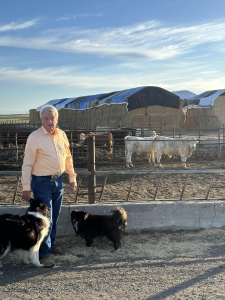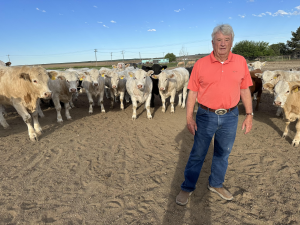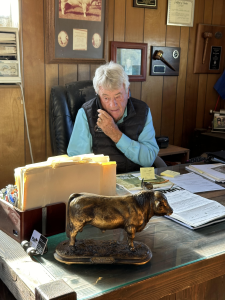Editor’s Note: This blog was authored by Jayden Rehwalt, ICL’s 2024 Andrus Scholar. As an environmental studies student at Boise State University, Jayden’s time with ICL is focused on climate and energy work. For this blog, Jayden brings a unique personal perspective: her grandfather is Roy Prescott, who owns and runs the ranch featured in this piece. When asked about her grandfather’s ability to embrace both his family’s past with the land while taking steps toward a sustainable future, Jayden shares: “I’m deeply proud to see his support for this renewable energy project (Lava Ridge Wind Project). In addition to safeguarding our land, his commitment is to create a legacy of stewardship and sustainability that aligns not just with the needs of our family, but with the needs of our community and beyond.”
In the wide open landscape of Jerome, Idaho, Roy Prescott’s livelihood lies at the intersection of tradition and innovation. The family ranch, started by Tom Prescott, Roy’s father, has been in operation since 1954. Roy took over in 2003, taking the reins from his dad while bringing in some new ideas.

Prescott’s education in Animal Science and Economics from Brigham Young University has shaped his perspective about the importance of environmental stewardship, resource management, and the historical preservation of the Minidoka Internment Camp Monument. He has used his knowledge of ranching as a platform to offer a unique perspective while serving on state and federal environmental resource committees and public service roles such as serving as a Jerome County Commissioner.
Prescott’s mix of educational background, boots-on-the-ground experience, and public service allows him to offer a comprehensive outlook on the newest potential change facing southern Idaho: the Lava Ridge Wind Project.
The Lava Ridge Wind Project, which is proposed by Magic Valley Energy, is slated to be among the largest in the western United States. It aims to install up to 241 wind turbines, capable of producing 750-1,200 megawatts of power. It would expand across private and public lands northeast of Twin Falls. The project has garnered quite a bit of media attention, as well as local opposition that include a variety of concerns—some of which are legitimate concerns over impacts to natural and cultural resources, and others of which are based on misinformation or messaging pushed by the fossil fuels industry. Despite this pushback, Prescott stands in support of the project, acknowledging the potential impact on his ranch’s extensive use of the public rangelands.

“The project that is being proposed is on Bureau of Land Management (BLM) land,” Prescott explains. “It’s the largest renewable project like this they have ever had. The final impact statement was expected[long] ago but BLM couldn’t have expected the amount of public comments they received.”
While many of the public comments received by BLM have been based on misinformation, others point out real concerns over impacts of the project. One of the biggest alarms that has been raised is regarding visual impacts to the nearby Minidoka National Historic Site.
Prescott shares these concerns. As a teenager, he remembers moving cattle through the site and seeing the grave markers that were left. During his time as Jerome County Commissioner, he took on a crucial role in establishing the recognition of the historic site and continued supporting the Friends of Minidoka group by hosting barbecues for the annual pilgrimage. Today, Prescott is still concerned about the preservation of the site, especially when he learned that some of his grandchildren have direct ties to the internees. He has been advocating for the Lava Ridge Wind Project to be relocated farther away from the historical site to preserve the visual and sacred feeling that the site holds.
A project like Lava Ridge also presents a new outlook for traditional rural lifestyles that have relied on routine. Prescott’s openness to change speaks volumes. “In my age, I am very comfortable with what has been around for a long time, routine is good—it’s the vocabulary I speak,” he admits candidly. “But the reality is that you recognize it has to change, and my hope is that those that populate the United States do it the right way.”
While change can often be challenging, Magic Valley Energy’s commitment to responsible development and investment in rangelands has earned Prescott’s favor. “They have worked with us [the ranching community] quite a bit to address any concerns we have,” Prescott acknowledges. “They will be responsible for any issues related to the project and have been open and honest about that.”

Prescott lists his main concern as the construction period of the project. Any land used for the project would be mostly unusable for the duration of construction, leading to a big impact on migratory animals. After hearing these concerns, the project developers announced plans to pause construction during prime grazing and migration seasons.
Construction plans also include the opportunity for Magic Valley Energy to invest in new rangeland technologies and landscape changes that could be exciting for ranchers in the area. Some of the new investments Prescott is most excited about include radio fencing to keep cattle away from construction, physical fencing near high traffic areas that Prescott could utilize to better organize pastures, and the development of new wells. These new wells would only be used by the developer for construction, so once that period is over, the wells would be an extremely valuable water source for ranchers who rely on their grazing rights on public lands and have spent years trying to get permitting for new water sources.
Prescott has also voiced his appreciation for the attention to detail and the willingness to find collaborative solutions between land users and the project developers. As his family continues to grow and Prescott looks to his grandchildren and great grandchildren, he understands the need for innovation. Maintaining the family ranch for many generations to come and ensuring a prosperous future for generations to come will require bold steps like the Lava Ridge Wind Project.
“When it’s finished, large or small, it will be better rangeland, better public land, than what it is today,” Prescott predicts. Not only will Prescott get better rangeland through the project’s development, but he will get to share it all with turbines that will power thousands of local homes around the West with clean renewable energy technology that will allow future generations to enjoy the land. The transition away from fossil fuels is also crucial to curtailing the impacts of climate change, including longer wildfire seasons and smokier skies, unbearable heat, and the extinction of fish, wildlife and plant species. To protect Idaho’s unique way of life from climate change, we must stop burning fossil fuels, which means we must get more renewable energy projects up and running.
Dive deeper into ICL’s stance on the Lava Ridge Wind Project here, and sign up for our Climate Campaign updates to get stories like this delivered right to your inbox.

